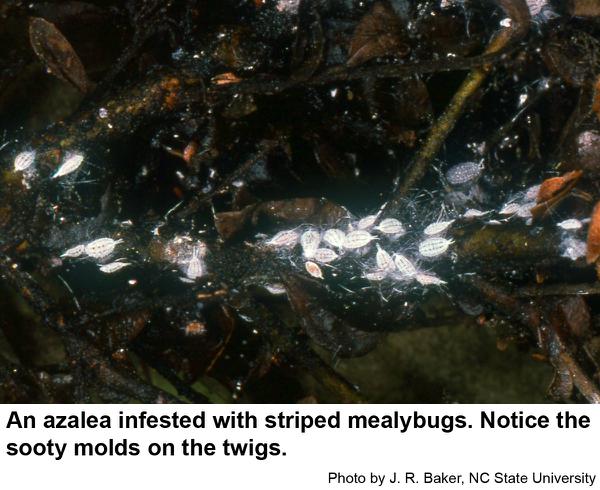Description and Biology
The striped mealybug, Ferresia virgata, is one of the showier mealybugs. Females are up to 3/16 inches long, and covered with a fluffy, white secretion except for two dark stripes down the back. This mealybug also has slender, clear, hairlike secretions protruding through the fluff as well as two noticeable, white, tail filaments. Males have two wings, long antennae, well developed legs, and a pair of long, white filaments at the rear. Males do not have mouthparts and live only three or four days. Over a period of 20 to 29 days, each females lays 64 to 737 eggs on a pad of fluffy filaments beneath her. Eggs hatch 30 minutes to 4 hours later. Female nymphs molt three times and male nymphs molt four times before molting into the adult stage a month or two later. Striped mealybugs often cluster around terminal shoots and leaves. During cold weather, females crawl down into the soil beneath their host plants
Host Plants
Striped mealybugs have been reported from over over 203 genera of plants in 77 families including field crops, vegetable crops, fruit crops, and ornamental crops. In North Carolina, we have seen it primarily on landscape azaleas and yaupon holly. Heavy infestations result in yellowing, withering and dieback of plants as well as premature leaf drop. They sometimes excrete enough honeydew to disfigure foliage with resulting sooty molds. Sooty molds sometimes become so dense that they reduce photosynthesis and plant vigor.
Residential Recommendations
Striped mealybugs are plagued with a number of parasitic wasps, lady beetles, and other predaceous insects. Even so at times these mealybugs are overlooked by beneficial insects and may threaten the beauty and health of their host plants. Striped mealybugs are susceptible to most insecticides labeled for residential landscape use although two or three applications may be necessary because these mealybugs even retreat into the soil during the winter.
References
- Common name: striped mealybug, scientific name: Ferrisia virgata Cockerell (Insecta: Hemiptera: Pseudococcidae). McCorquodale, A. and A. Hodges. 2016. Featured Creatures, Entomology & Nematology, FDACS/DPI, EDIS. Publication Number: EENY-674.
- Ferrisia virgata (striped mealybug). Anonymous. 2018 (last modified). CABI Invasive Species Compendium Data Sheet.
-
Horticultural Oils for Ornamental Plants. Frank, S. et al. 2018. Entomology Insect Notes, NC State Extension Publications.
-
Sooty Molds. Frank, S. et al. 2002. Entomology Insect Notes, NC State Extension Publications.
- Extension Plant Pathology Publications and Factsheets
- Horticultural Science Publications
- North Carolina Agricultural Chemicals Manual
For assistance with a specific problem, contact your local N.C. Cooperative Extension Center.
This Factsheet has not been peer reviewed.
Publication date: Jan. 27, 2018
Reviewed/Revised: Nov. 4, 2022
Recommendations for the use of agricultural chemicals are included in this publication as a convenience to the reader. The use of brand names and any mention or listing of commercial products or services in this publication does not imply endorsement by NC State University or N.C. A&T State University nor discrimination against similar products or services not mentioned. Individuals who use agricultural chemicals are responsible for ensuring that the intended use complies with current regulations and conforms to the product label. Be sure to obtain current information about usage regulations and examine a current product label before applying any chemical. For assistance, contact your local N.C. Cooperative Extension county center.
N.C. Cooperative Extension prohibits discrimination and harassment regardless of age, color, disability, family and marital status, gender identity, national origin, political beliefs, race, religion, sex (including pregnancy), sexual orientation and veteran status.


